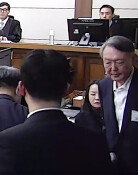[Editorial] Historic Family Reunion
[Editorial] Historic Family Reunion
Posted August. 15, 2000 21:50,
This was a day that a sea of tears drenched the whole nation, not only the reunited families but also those who watched them meet and wept! A son shouted ¡°mom, mom, mom!`` Shedding a cascade of tears, he couldn`t say anything but that single word, "mom!" ¡°I missed you so much all these years, my son!`` replied the mother. They have waited for this reunion day for the last fifty years. But the two-hour reunion on August 15 was a far too brief meeting for them.
Tuesday`s reunions of 100 separated families each from the South and the North at Seoul`s COEX Center and Pyongyang`s Koryo Hotel mesmerized all our compatriots on both sides with deep emotions, as well as the world community that watched the touching scene. The occasion made us realize anew humanity¡¯s moral imperative to realize that nothing can be more precious than the blood-bonds between kith and kin. No ideology or political system can destroy this bond, nor is it expendable for anything in the world.
The historic reunion of separated families was the highlight of the new millennium`s first Liberation Day anniversary, which we observed Tuesday after 55 years of division and 50 years after the Korean War. The reunions have an intrinsic value in themselves, but are additionally significant in that they signal further peace and reconciliation on the Korean peninsula, the world`s only remaining Cold War region. The fact that the reunited families will fly to their destinations under each country¡¯s flag carrier is an epochal move that drives home the reality of inter-Korean detente.
Let it not be forgotten, however, that the deep emotions and excitement of the reunions will only represent a first step on the long road of reconciliation and integration between the two Koreas. There are still many hurdles ahead of us. There are many millions of separated family members whose status has yet to be confirmed. Among them, there are hundreds of thousands of wartime contemporaries whose old age may hardly leave them with enough time for future reunions. There were, for example, two cases of separated family members who died while waiting after the notification of their inclusion in Tuesday`s reunion list. This shows us the reason why we should greatly increase the frequency of the reunions and the number of the families involved.
There is also a need to ease the current limitations on the time and places of the reunions. President Kim Dae-Jung and North Korean leader Kim Jong-Il indicated that the separated families will in the future be allowed to visit their hometowns and to choose their places of residence and permanent union. Humanistic considerations to advance such a step should be taken as soon as possible. This should present no problem if we succeed in building mutual confidence.
Mutual love and humanism of fellow compatriots that transcends political fetters can make possible our reunions as a first step for genuine inter-Korean reconciliation. Seoul and Pyongyang should recognize that they mutually share pain and separation. Every kind consideration and help must be rendered to the separated family members until their safe return. This may eventually secure the process to build a lasting structure of peace on the peninsula.






![“설거지해도 그대로”…냄비 ‘무지개 얼룩’ 5분 해결법 [알쓸톡]](https://dimg.donga.com/c/138/175/90/1/wps/NEWS/IMAGE/2026/01/15/133164664.3.png)
